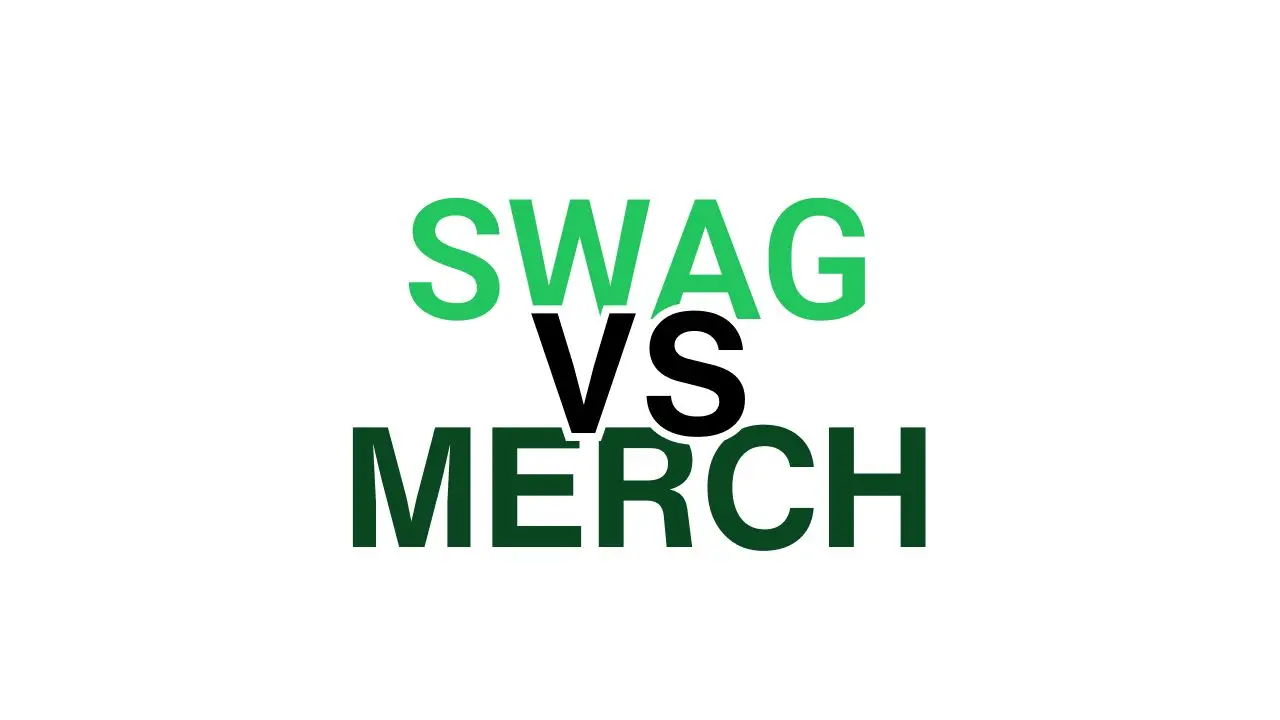Swag vs Merch: The Differences Between the Two Terms
Marequitta D. - Author
Marequitta has over 8 years of prior writing experience plus 6 years of customer service experience. She's successfully worked with many companies of all sizes.In case you’re new to the world of promotional products business, you must’ve heard about the terms swag and merch used by marketing people when discussing products and items. It can sometimes be used interchangeably, but other people use these terms for specific products. Today we will find out what the terms mean and what kinds of clients use them.
The Definition of Swag
When salespeople give away promotional products to potential clients or customers to encourage them to make a purchase, it is called swag. Think of items you may get at a trade show or in a gift bag. Swag is purposefully created to give to customers as a physical and tangible token that bears the company’s brand name on it. This is done in order to elicit a subconscious response from them and encourage them to purchase products or services from the company at a later time.
Depending on the company event that your client wants to attend, the type of swag you’ll recommend to them may also vary. For example, if your client wants to have their own booth at a trade show, you could recommend a high-quality pen with a custom message, a notepad with their logo, or a tote bag that their customers can reuse.
What is Merch?
Merch is short for merchandise, which refers to items sold or distributed by a brand or artist to their fans or customers. Merchandise is usually available for purchase and is often associated with a specific brand, artist, or event. Examples of merch can include clothing (t-shirts, hoodies, hats), accessories (bracelets, necklaces), posters, albums, or any other items featuring branding or artwork related to the brand or artist. Merchandise serves as a way for fans to show support and affiliation while also providing a revenue stream for the brand or artist.
The Evolution of Swag Into Merch
The evolution of swag into merch can be seen as a progression from free promotional items to branded merchandise that is sold or distributed to fans or customers. Here's how the transition may occur:
- Swag as promotional items: Initially, swag refers to free promotional items given away by brands at events or trade shows. These items are designed to create brand awareness and leave a positive impression on recipients. Swag typically includes items like pens, keychains, and stickers, featuring the brand's logo or slogan.
- Expansion of swag: As brands recognize the value of promotional items, they may start offering a wider range of swag to engage with their target audience. Swag items can include t-shirts, tote bags, water bottles, and other practical or novelty items that bear the brand's logo or artwork. The goal is to create a sense of loyalty and connection to the brand.
- Swag as limited edition: Some brands may begin to produce limited-edition or exclusive swag items to generate excitement and demand. These items are often associated with specific events, collaborations, or milestones. Limited-edition swag can create a sense of exclusivity and become more sought after by fans and collectors.
- Transition to merch: As the popularity of swag grows, brands may start to explore the sale of branded merchandise, often referred to as merch. This transition involves offering a wider range of products, including clothing, accessories, posters, and albums, which fans can purchase to show support for the brand or artist.
- Enhanced design and quality: Merchandise tends to have a more refined design and higher-quality materials compared to traditional swag items. Brands invest in creating appealing artwork, incorporating unique designs, and ensuring that the merchandise aligns with their brand identity. This helps to attract customers who are willing to pay for these items.
- Fan engagement and revenue generation: Merchandising becomes a means for brands, artists, or organizations to engage with their fans on a deeper level. Fans can proudly wear or display merch, showing their support and affiliation. Additionally, merch sales become a revenue stream for brands, contributing to their financial sustainability and growth.
Why People Stopped Calling It Swag
The term swag becoming synonymous with merch can be attributed to the evolving language and cultural shifts within marketing and branding practices. Here are a few possible reasons for this transition:
- Popularization and reappropriation: The term swag originally referred to free promotional items given away by brands. However, over time, the term gained popularity and became more widely used in popular culture. As a result, it started to encompass a broader meaning beyond just promotional items, extending to branded merchandise that fans or customers can purchase to show their support. This expansion of the term swag allowed it to encompass both free promotional items and paid merchandise.
- Language evolution and colloquial usage: Language is constantly evolving, and terms can change in meaning or acquire new connotations. In the case of swag, its colloquial usage extended beyond its original promotional context. People began referring to branded merchandise as swag in a broader sense, regardless of whether it was given away for free or sold. This colloquial usage led to the merging of the terms swag and merch in the popular vernacular.
- Influence of popular culture and social media: Popular culture, particularly music, influencers, and social media platforms, has played a significant role in shaping language and trends. Artists, celebrities, and influencers often use the term swag to refer to their branded merchandise or products associated with their personal brand. This usage further popularized the term and contributed to its association with merchandise.
- Marketing and branding strategies: Brands and marketers often adopt and adapt popular language and cultural references to connect with their target audience. The term swag gained attention and recognition among younger demographics, making it an attractive and relatable term to use when promoting and selling merchandise. By aligning with popular language and cultural trends, brands can leverage the appeal and recognition of the term swag to generate interest and increase sales of their merchandise.
It's important to note that the term swag being used interchangeably with merch may vary in different contexts and regions. Language and terminology can be influenced by various factors, and different industries or communities may have their own unique interpretations and usage of these terms.
Recent Posts
20 Self Care Tips For Ent...
Entrepreneurs who run their own ventures, due to their strong drive for success, almost always prior...
8 minute read
Created by Marequitta
on April 24, 2023
Selling Print on Demand P...
If you’re an aspiring art photographer, then you must already be familiar with the challenging and c...
5 minute read
Created by Marequitta
on April 11, 2023
Print On Demand Sustainab...
Is it possible for print on demand to be sustainable? Both for your business, the state of the plane...
6 minute read
Created by Marequitta
on March 23, 2023

